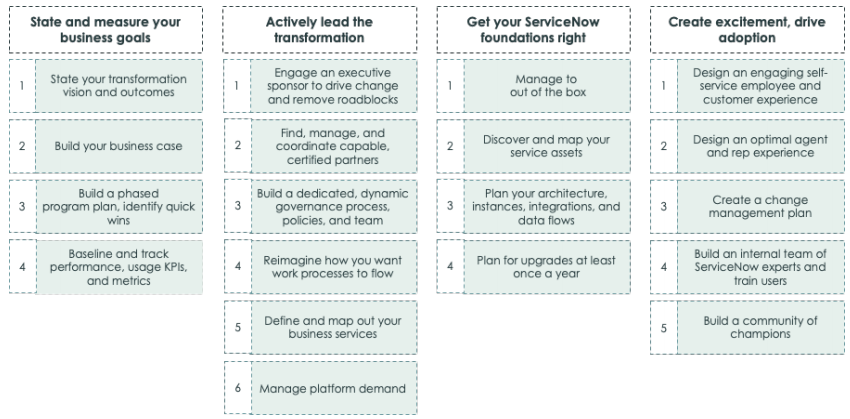ServiceNow enables enterprises to define services, provide an intuitive service experience, deliver services, assure service availability and analyze critical service metrics. For this reason, ServiceNow is being widely adopted by businesses. Looking at the scope it operates in, the operational efficiencies it drives, and the impact it has on an organization’s culture, it is easy to understand why ServiceNow is not just a tool, but rather a digital transformation strategy. To get better results with ServiceNow, organizations need to have a robust ServiceNow implementation strategy. Without one, most organizations fail to get the best results out of ServiceNow. We provide a complete walkthrough of a successful implementation process to unveil the power of the Now Platform and transform your business.
The ServiceNow Platform Implementation Process
As we just mentioned, one of the biggest mistakes of a ServiceNow implementation is not doing your due diligence before starting. Here are a few steps to get you started:
1. Analyze Organizational Goals and Create Roadmap
For any implementation, an organization needs to have a clear and definitive objective and outcome. Similarly, with ServiceNow implementation clearly state the objectives and results you foresee and formulate how accurately the outcomes are aligned with business goals. Develop an implementation roadmap and make sure these are well documented and measurable.
Consider the business challenges to solve and areas to improve and then develop use cases with respective ServiceNow implementation propositions. Develop a strategic phase-wise implementation plan based on Long and short term golas and priorities. To track progress and ensure the implementation process is in line with the expected results, develop key performance indicators and metrics. Develop a transparent strategy to manage sponsors, stakeholders, and partners. Here are the key steps involved in this process:

2. Mapping Strategy to Implementation
A ServiceNow implementation has to be approached with a strategic perspective rather than a "buy-deploy-use" approach. So, having a great vision isn’t enough to get your implementation right, the vision would fail if the strategy isn’t accurately aligned with reality.
Start the process by specifying ServiceNow’s responsibility and strategic value it's expected to deliver. Define your vision, key drivers, anticipated results, and key performance indicators. Constantly monitor your implementation progress and analyze any deviations, one can run a gap analysis between present and essential competencies to stay in line with project strategy, cost and time.
Making changes to business operations may result in disruptions or service outages, always have strong ServiceNow change management processes in place to monitor the impact of changes.
Key Tasks:
- Relate vision with value
- Develop implementation around anticipated results
- Locate and resolve gaps
- Map business needs with ServiceNow abilities
- Develop a phase-wise implementation strategy
- Determine high priority tasks
- Track changes
3. Explore Opportunities to Expand Vision
ServiceNow implementation is a strategy because the ServiceNow platform is designed to inspire organizations to innovate service delivery. After numerous implementations and iterations, one might find areas for further improvement and explore new business opportunities. Share a performance report to the respective leaders and get their feedback to evolve and ServiceNow implementation roadmap.
4. Work with a ServiceNow Retainer Team
Finding skilled, experienced, and trustworthy development resources at budget-friendly prices can be a daunting task for most businesses. A ServiceNow Retainer Team can add value to the client because it is composed of professionals who can cost-effectively provide quality work. ServiceNow Retainer Teams should consist of a diverse set of experienced and skilled professionals who can fit into the designated roles and deliver the project successfully. Here are the key roles any development team should consider for a ServiceNow upgrade or implementation.
- Certified and Experienced Developers
- Implementation Specialist
- Technical Project Manager
- Process Consultant
- Quality Assurance Tester
- Engagement Manager
Conclusion
To reap the full benefits of ServiceNow, businesses need to assess their needs, map areas where ServiceNow should be implemented, develop strategy, define a clear roadmap, list out KPIs, monitor progress in a timely fashion, and restructure implementation strategies as needed. In short, businesses must remember that the ServiceNow platform is more of a strategy than mere technology deployment, so a successful roadmap is key!
















